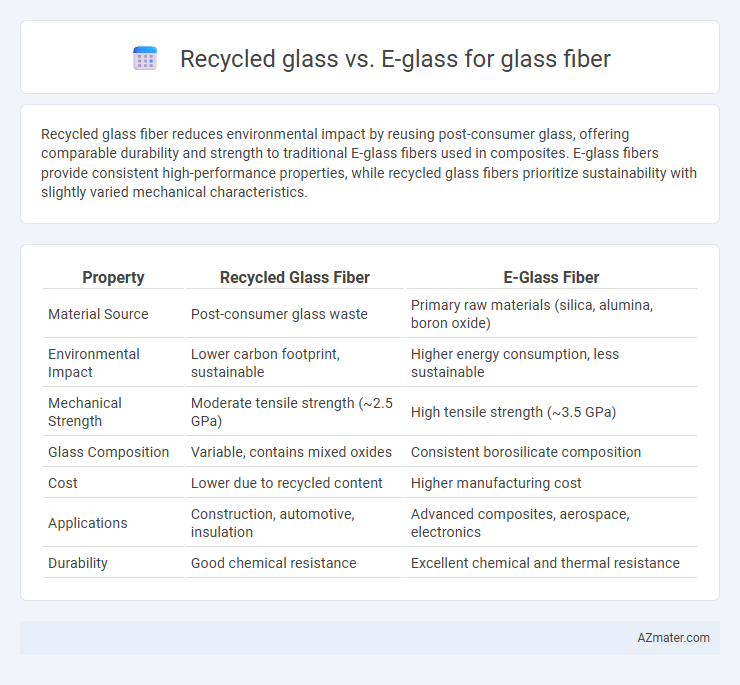Recycled glass fiber reduces environmental impact by reusing post-consumer glass, offering comparable durability and strength to traditional E-glass fibers used in composites. E-glass fibers provide consistent high-performance properties, while recycled glass fibers prioritize sustainability with slightly varied mechanical characteristics.
Table of Comparison
| Property | Recycled Glass Fiber | E-Glass Fiber |
|---|---|---|
| Material Source | Post-consumer glass waste | Primary raw materials (silica, alumina, boron oxide) |
| Environmental Impact | Lower carbon footprint, sustainable | Higher energy consumption, less sustainable |
| Mechanical Strength | Moderate tensile strength (~2.5 GPa) | High tensile strength (~3.5 GPa) |
| Glass Composition | Variable, contains mixed oxides | Consistent borosilicate composition |
| Cost | Lower due to recycled content | Higher manufacturing cost |
| Applications | Construction, automotive, insulation | Advanced composites, aerospace, electronics |
| Durability | Good chemical resistance | Excellent chemical and thermal resistance |
Introduction to Glass Fiber Materials
Glass fiber materials primarily consist of silica-based fibers used for reinforcement in composites, with E-glass being the most common type known for its excellent electrical insulation and mechanical properties. Recycled glass fibers are derived from post-consumer or industrial glass waste, offering an eco-friendly alternative that reduces environmental impact and energy consumption during production. Comparing recycled glass to E-glass involves assessing factors like strength, durability, and cost-effectiveness, where recycled fibers may have slightly lower performance but contribute significantly to sustainability goals.
Overview of Recycled Glass in Fiber Production
Recycled glass in fiber production offers a sustainable alternative to traditional materials by utilizing post-consumer and industrial glass waste, significantly reducing energy consumption and raw material usage. It maintains comparable mechanical properties to virgin E-glass fibers while lowering the carbon footprint and landfill waste associated with fiber manufacturing. Advances in processing technologies enable high-purity recycled glass fibers that support automotive, construction, and insulation applications with improved environmental performance.
What is E-Glass? Composition and Properties
E-glass, or electrical-grade glass, is a type of glass fiber primarily composed of approximately 54-56% silicon dioxide (SiO2), 14-16% aluminum oxide (Al2O3), 11-13% calcium oxide (CaO), 4-6% boron oxide (B2O3), and small amounts of magnesium oxide (MgO) and sodium oxide (Na2O). Known for its excellent electrical insulating properties, high tensile strength, chemical resistance, and thermal stability, E-glass is widely used in composites, electronics, and reinforcement applications. Compared to recycled glass fibers, E-glass maintains superior uniformity, performance consistency, and optimized mechanical properties crucial for demanding industrial uses.
Manufacturing Process: Recycled Glass vs E-Glass
The manufacturing process of recycled glass fiber involves melting post-consumer or industrial glass waste, significantly reducing energy consumption and raw material usage compared to virgin E-glass production. E-glass is produced through the melting of high-purity raw materials like sand, alumina, and lime at temperatures around 1400-1600degC, demanding higher energy input and emitting more CO2. Using recycled glass in fiber manufacturing lowers environmental impact while maintaining similar mechanical properties and performance levels in composites.
Mechanical Strength Comparison
Recycled glass fibers exhibit mechanical strengths typically ranging from 2,500 to 3,500 MPa in tensile strength, offering a sustainable alternative with moderate performance. E-glass fibers, standard in composite manufacturing, display superior tensile strengths around 3,400 to 4,000 MPa and higher modulus values, making them preferable for applications demanding maximum mechanical durability. Variability in recycled glass quality can influence fiber consistency, whereas E-glass benefits from controlled production processes ensuring uniform mechanical properties.
Environmental Impact Assessment
Recycled glass in glass fiber production significantly reduces raw material extraction and lowers energy consumption compared to traditional E-glass manufacturing, resulting in a smaller carbon footprint. The use of recycled glass minimizes landfill waste and decreases greenhouse gas emissions during melting, promoting circular economy principles. Life cycle assessments indicate that recycled glass fibers offer superior environmental performance without compromising mechanical properties.
Cost Efficiency Analysis
Recycled glass fibers significantly reduce production costs by utilizing waste materials, lowering raw material expenses by up to 40% compared to traditional E-glass fibers. E-glass fibers, despite higher initial costs due to virgin silica and energy-intensive manufacturing, offer consistent quality and performance that can justify their expense in high-strength applications. Cost efficiency analysis reveals that recycled glass fibers are ideal for budget-conscious projects prioritizing sustainability, while E-glass remains preferable where reliability and mechanical properties are critical.
Applications and End-Uses
Recycled glass fibers offer sustainable alternatives primarily used in insulation, construction composites, and automotive panels, leveraging eco-friendly benefits while maintaining thermal and acoustic properties. E-glass fibers dominate in high-performance applications such as aerospace, marine, and wind turbine blades due to superior tensile strength, durability, and electrical insulation. Both materials find end-uses in reinforced plastics and composite manufacturing, with recycled glass favored for cost-effective, environmentally conscious projects and E-glass driving innovation in demanding structural components.
Challenges and Limitations
Recycled glass fibers face challenges such as inconsistent quality, higher impurity levels, and reduced mechanical strength compared to E-glass fibers, which offer superior durability and thermal resistance. The variability in recycled glass feedstock leads to difficulties in controlling fiber diameter and surface properties, impacting composite performance and reliability. E-glass fibers, produced under controlled conditions, provide more uniformity and better compatibility with resins, making them preferable despite higher production costs.
Future Trends in Glass Fiber Technology
Recycled glass is gaining traction in glass fiber production due to its lower environmental impact and circular economy benefits, while E-glass remains dominant for its superior strength and thermal resistance. Future trends in glass fiber technology emphasize enhancing recycled glass purity to match E-glass performance, driven by sustainability regulations and cost-efficiency targets. Innovations in manufacturing processes aim to integrate more recycled content without compromising fiber quality, signaling a shift toward greener glass fiber composites.

Infographic: Recycled glass vs E-glass for Glass fiber
 azmater.com
azmater.com